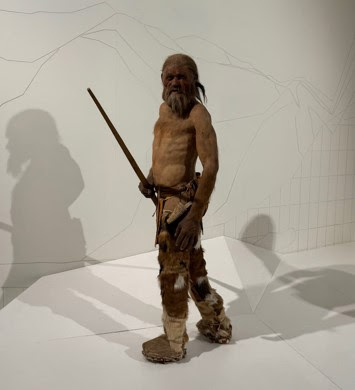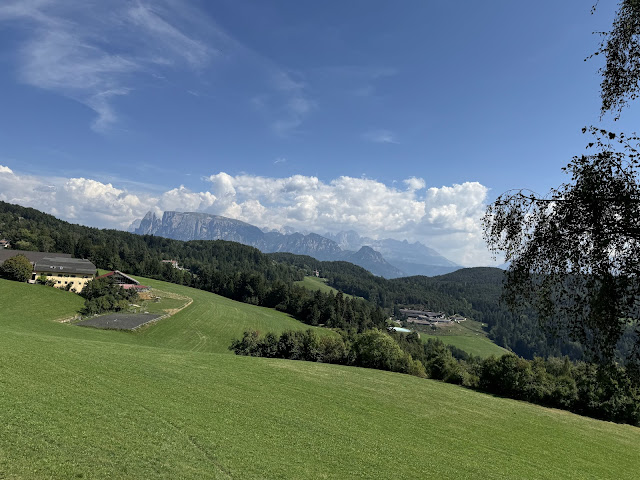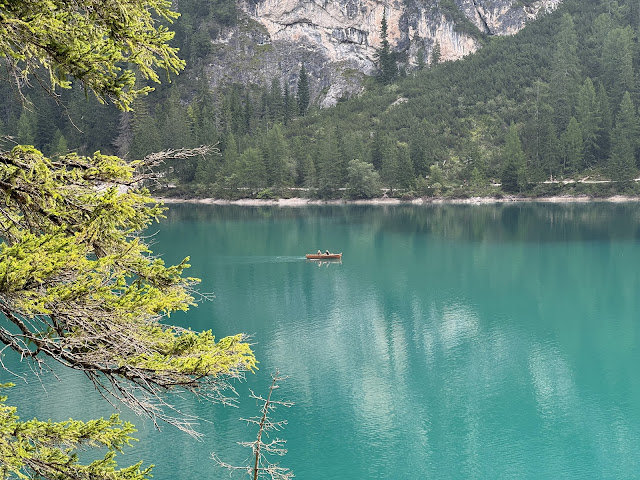After a long flight and a harrowing drive, we made it to Lake Garda. Driving on the motorway here is intense. From Milan there were three lanes - a slow truck lane on the right, a fast car passing lane one the left, and a kind of free-for-all slow car/fast truck lane in the middle. Within our first hour of driving we nearly got squashed like a grape in that middle lane because trucks pull over to the middle lane to pass without even checking their blind spots and you can’t swerve to the left because cars are swooping by in that lane with dizzying speed. My life flashed before my eyes but Kevin laid on the horn Italian style and we avoided disaster. Whew! On to the serenity of Lake Garda…
We stayed just two nights in Sirmione, a postcard-pretty town that is at the tip of a narrow peninsula. A castle built in the 1300’s by the Della Scala family straddles the town and the peninsula. Back in medieval times they could pull up the drawbridges to keep invaders from breaching any part of the peninsula.
We didn’t really have time to do this town justice in only two days, but we did manage to see the town’s other big draw — the ruins of an ancient Roman villa and bath complex dating from the first century BC. This area of Lake Garda is fed by underground geothermal streams, and even today there are a couple of well-known spas that have tapped into the hot sulfur springs that well up from the seabed just off the eastern shore of the peninsula. We took a boat tour and our guide was able to show us one of the offshore spots where the hot spring water bubbles up to the surface.
From Sirmione we drove north towards Bolzano, stopping along the highway at a farm restaurant for lunch. Kevin ordered the Knödel, a local South Tyrolean dish with dumplings that are similar to balls of tightly packed Stove Top stuffing only more flavorful and cooked in beer. They are tasty and very filling, and you can find them on every menu in this part of Italy.
We really liked the town of Bolzano. It was walkable and had many restaurants and cafes. We have now officially crossed into the South Tyrol region - you’ll hear German spoken here just as often as Italian. That’s because this area was a part of Austria until it was given to Italy after the end of World War I.
Bolzano is also home to the South Tyrol Archaeological Museum - a whole museum dedicated to just one find : the mummified remains of a Copper Age man, nicknamed Otzi. The mummy was found in 1991 in some recently thawing ice just a few meters inside the Italian border. At first he was thought to have been a climber who perhaps fell to his death sometime in the past century or so. But once scientists examined his gear and clothing, they realized he was much, much older - they estimate that he died around 3300 BC. Forensic tests found that he was murdered, having been shot in the back with an arrow that severed an artery in his shoulder. The glacial ice covered and preserved his body for the next 5300 years. You can view the remains, which are kept in a climate controlled chamber, but photos are not allowed out of respect. Instead visitors are encouraged to take pictures of a scientifically aided 3-D rendered sculpture of what he probably looked like in life.
On our second afternoon we took a cable car ride to the town called Soprabolzano on the ridge above the larger town. From the cableway we had panoramic views of the massive mountains in the distance. We are looking forward to some beautiful hikes in those mountains and the rest of the Dolomites beyond.
On our last evening in Bolzano we took a walking food tour and sampled some pretzels, bruschetta topped with speck (a local smoked ham similar to prosciutto), more knödel, and about six craft beer samples from a local brewery. We probably could have skipped the tour since none of the food was much different than what we had already tried for ourselves. But we did get a chance to see the city at night and saw the Cathedral of Santa Maria Assunta all lit up.
From Bolzano we drove ourselves to the town of San Candido (“Innichen” in German) in the Pusteria Valley. The view from our apartment balcony was absolutely breathtaking; photos don’t really do it justice.
We spent a week exploring the beautiful mountains and valleys in this region, and San Candido was an excellent town to base ourselves in, with great restaurants and cafes and two beautiful churches with instagram-worthy towers.
One of the most popular spots in this area is the scenic Lago di Braies. The mountain lake has been a bit over-touristed in recent years, so the local authorities have restricted access to the road during the busy summer season. We were luckily able to reserve a parking pass on short notice and we arrived early enough to enjoy a peaceful stroll around the lake path.
One of the reasons why Lago di Braies is so popular is because of the beautiful blue hue the water takes on when the sun hits it. Powdery silt in the form of “glacial flour” is suspended in the lake, which turns the water a turquoise blue that seems to glow in the reflected sunlight.
A short detour from the lake path took us up to Malga Foresta. A “malga” is an alpine farmstead. Some of them are just regular farms, while others also have a small restaurant serving hearty dishes fit for a hardworking shepherd. We ordered a breakfasty dish that had a description of ham and eggs with roasted potatoes. It turned out to be four slices of speck layered over four eggs with a generous portion of potatoes as a base. We could easily have shared one plate had we known about the massive portion sizes!
From the balcony of our apartment we can see the Mount Baranci chairlift so we decided to take it up to the top of the hill. We took a hiking trail that claimed to arrive at a Malga. And we soon learned that not every Malga is a farmstead restaurant, some are just private farms. Disappointed and hungry we continued on down the muddiest hiking “path” ever, back to the restaurant at the big ski lodge at the top of the chairlift. At least the scenery was beautiful! And I loved the Lodge's garden of wildflowers that were still blooming even this late in the season. I can't imagine how pretty the mountain meadows must be in the height of summer.
Our week in San Candido/Innichen was pretty ideal. The town was small enough to be walkable, there was excellent hiking nearby, and even if we didn't have a car we could have used the excellent public bus system or rented bikes to ride on one of the many bike paths. I also really appreciated the variety of dishes that were offered at the restaurants. Usually at tourist places in Italy we see the basic 3 Ps - pizza, pasta, panini. But here with the Austrian influence we had the additional option of the 4 Ss - schnitzel, sausages, spaetzle, and strudel. Not to mention the knödel, goulasch, venison, and yummy roasted potatoes. I'm beginning to suspect that this will end up being my favorite part of Italy.
















No comments:
Post a Comment